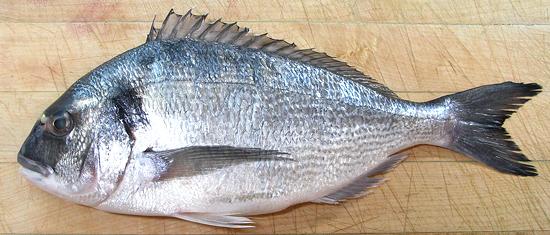 [Dorata (Spain); Orata (Italy); Dorade royale (France);
Sparus aurata of family Sparidae]
[Dorata (Spain); Orata (Italy); Dorade royale (France);
Sparus aurata of family Sparidae]
This fish is native to the Mediterranean, Black Sea and East Atlantic from southern Morocco to southern Norway. It is considered a prized eating fish throughout its range. Gilt-head comes from the the gold bar that extends from one eye to the other, visible in the photo. The photo specimen was 12-3/4 inches long and weighed 1 pound 3-3/8 ounces. This fish is now farmed, so market fish may come from far outside its natural range.
More on Porgys and Seabream.
The flesh of this fish is white, with a light and quite pleasant taste. There is a narrow darker streak along the centerline right beneath the skin. It's texture is a bit different, but the flavor not noticeably stronger than the white flesh. Because the flavor is quite light, I recommend poaching or steaming this fish, skin-on or skin-off. It should be eaten with a lightly flavored sauce or dip. I use my standard Lemon Wine Sauce. This fish makes an excellent fish stock.
Buying: This fish is not common here in Southern California, though other Seabream and Porgys are. The photo specimen was purchased from a large Asian market in Los Angeles (San Gabriel) for 2019 U.S. $4.99 / pound.
Scales: This fish is covered with thin medium size scales with moderate adherence. They are not hard to scrape off and don't fly about much.
Cleaning: This fish is a little more difficult to clean than some, because of tough membranes and a swim bladder in the body cavity. The gills don't pull really hard, but aren't easy to get at, so use your long nose pliers. Break the tough membrane at the top of the body cavity so you can scrape out the blood works just below the backbone. The pliers can also be helpful pulling out membranes.
Fillet: This is an exceptionally easy fish to fillet, with a coherent, easy to follow bone structure. Cut down to the backbone, then over the backbone at the tail and forward. When you get to the rib cage, use kitchen shears to cut the ribs from the backbone, then pull them from the fillet with long nose pliers. There are short but substantial centerline pin bones which must be pulled for the length of the body cavity. They are easy to find, but dive the points of your long nose pliers fairly deep into the flesh because the top end breaks off easily.
Skin: The skin does not have a strong, oily or off flavor. Skin shrink is initially strong, but not persistent. When pan frying fillets, you can flip them over skin side down and just hold them flat for a few seconds and they will stay flat. For poaching skin-on, I cut the fillets into two narrow ones so the curl is limited and I don't need the water to be too deep. After poaching, the fillet can be placed on the plate skin side down and it will be completely flat. If you desire to skin fillets, the skin is thin but tough when raw, so it can be easily done using the standard long knife and cutting board Method. Since the skin does not have a strong flavor it should be added to the stock pot along with the heads, fins and bones to add body to the stock.
Yield: A 1 pound 3-3/8 ounce fish yielded 9-5/8 ounces of skin-on fillet (50%). Skin off that would be 9.1 ounces (47%).
Stock: The head, bones, fins and skin make an excellent light colored stock with a medium light flavor. It is so good it needs no other flavoring except a little salt. Remove the small amount of oil using your gravy separator. For details see our Making Fish Stock page.
sf_seabrmuz* 160606 - www.clovegarden.com